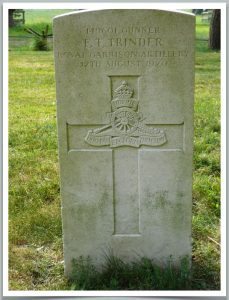Royal Garrison Artillery

Frederick Thomas Trinder was born at Highnam, near Gloucester in 1896. Records show that he was baptised on 6 September of that year.
He was the son of John James Trinder (1857-1935) a waggoner on a farm and his wife Alice Elizabeth (née Merrick: 1857-1921). The couple had three children, Frederick and sister Ethel Elizabeth (born 1886); another daughter Alice Lillian was born in 1892 but died in 1908.
At the time of the 1911 Census the family lived in Highnam. The census notes that Frederick, aged 14, was a ‘worker’ but gives no occupation.
An Army Service Record has survived for Frederick, so we can build a picture of his Army service and reason for his discharge, He attested for military service, for the duration of hostilities on 25 October 1915 at Hereford. He gave his correct age as being 19 and two months, his occupation as a van man and his address as The Stores, Preston on Wye, Hereford. His mother was recorded as his next of kin.
He was posted to the Royal Field Artillery (RFA) as a Driver, number 112719.
He joined the RFA at Preston on 27 October 1915 and was posted to the 8th Reserve Battery on the following day. He then spent the remainder of his time with the RFA serving with anti-aircraft (AA) units, latterly at Shoeburyness from 24 May 1916 and with 167th AA Section from 20 June 1916 until the end of the year.
On 1 January 1917 he transferred to the Royal Garrison Artillery (RGA) as a Gunner and was given a new number, 149601. He was posted to the British Expeditionary Force on the Western Front on
8 January 1917 and served in AA batteries and base establishments up to the Armistice.
He was demobilised on 10 June 1919 and there is a reference in one of his service papers of his being located in what was the post-Armistice Army of Occupation in Germany.
Frederick returned home to live at 2 Mile House, Huntley Road, Gloucester. He had been diagnosed as suffering from pulmonary tuberculosis, attributable to his war service and from 6 March 1920 he was in receipt of a 100% disability pension.
Treatment for tuberculosis at that time was very limited and like so many infected he eventually died from it , aged 24 at Highnam on 12 August 1920.
He was buried in the churchyard of Highnam Parish Church, where a standard CWGC headstone marks his grave.
Research by Graham Adams 27 March 2020
